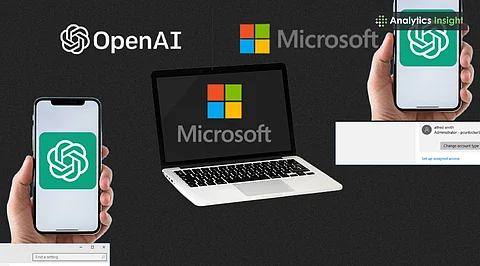

Microsoft's deep partnership with OpenAI accelerates its Azure cloud dominance.
Exclusive access to advanced AI models keeps Microsoft ahead of competitors.
Microsoft's strategic investment ensures leadership in artificial intelligence innovation.
Microsoft's intense interest in OpenAI is not just curiosity; it's a strategic decision aimed at shaping the future of technology. To understand why Microsoft is obsessed with OpenAI, it's essential to look at multiple dimensions: financial gains, technological leadership, market competition, and future innovations.
Microsoft first partnered with OpenAI in 2019, investing an initial $1 billion. Since then, the company's investments have grown significantly, totaling around $13 billion by 2025. In return, the tech giant secured exclusive rights to host and deploy OpenAI’s advanced AI models on its Azure cloud platform. Azure became the central hub for OpenAI's technologies, significantly increasing its revenue from cloud services.
Microsoft's Azure cloud revenue surged nearly 39% year-over-year by mid-2025, largely driven by AI workloads. This success made the Azure platform a major profit center, growing to more than $75 billion in annual revenue. The company’s market value, largely due to its AI and cloud strategy, approached an impressive $4 trillion by 2025.
Microsoft has integrated OpenAI's artificial intelligence into almost every key product. Windows 11, Microsoft 365, GitHub, and the Edge browser all use OpenAI's technology. A prominent example is Copilot, its AI assistant embedded within these platforms, making tasks easier for users by assisting with writing, coding, and organizing data. Copilot's success has attracted over 100 million monthly active users, further locking customers into the company's ecosystem.
During the Microsoft Build Conference 2025, the company revealed more advanced AI tools built upon OpenAI's newest model, GPT-5. Microsoft announced a new feature called "Smart Mode," allowing Copilot to automatically switch between different AI models based on user needs. This seamless integration helps the company maintain its competitive edge by enhancing the user experience.
OpenAI's advanced capabilities have drawn attention from Microsoft’s competitors like Google, Oracle, Meta, and even Elon Musk’s xAI. As competition grows, Microsoft's strong relationship with OpenAI becomes crucial. By maintaining exclusive or priority access to OpenAI’s latest innovations, Microsoft can limit the potential for competitors to surpass it in AI development.
However, OpenAI has begun exploring relationships with other companies and cloud platforms, including Google and Oracle, to avoid becoming overly dependent on the company's OS. This openness has put pressure on Microsoft to maintain a beneficial and secure relationship to avoid losing its strategic advantage.
Also Read - OpenAI Introduces ChatGPT Study Mode to Boost Student Learning
One of the unique aspects of the tech titan's agreement with OpenAI relates to Artificial General Intelligence (AGI), AI capable of performing tasks as effectively as humans. The original partnership agreement stated that if OpenAI achieves AGI, Microsoft’s access to future developments might be limited. To avoid losing this critical advantage, Microsoft is currently renegotiating its agreement with OpenAI to ensure continuous access to future AI models, even after AGI milestones are reached.
This renegotiation also addresses Microsoft's financial interests and its equity stake in OpenAI. Ensuring ongoing access to cutting-edge AI remains a top priority for Microsoft, given the significant financial investments made.
The tech leader’s initial $13 billion investment also comes with significant financial incentives. Under their current arrangement, Microsoft is entitled to 49% of OpenAI’s profits, limited to roughly ten times its initial investment. This setup ensures that the company benefits greatly from OpenAI’s commercial success.
OpenAI’s latest model, GPT-5, due for release in late 2025, is expected to drive further adoption of Microsoft's products. The financial benefits from AI-related sales, licensing fees, and cloud computing services tied to OpenAI's technology make the partnership extremely valuable for Microsoft.
Recently, OpenAI expressed interest in operating more independently by diversifying its partners beyond Microsoft. This move raised alarms within Microsoft, leading it to push for clearer terms in its agreement. Microsoft wants to secure long-term rights to OpenAI's technology and maintain its market leadership in AI-driven cloud services.
OpenAI also announced plans to release an open-source AI model called o3-mini. This open-source model means other companies could use OpenAI's technology without needing Microsoft's cloud services, potentially weakening Microsoft's control over OpenAI’s technology distribution.
Artificial Intelligence is quickly becoming the most critical area of technological development, revolutionizing how businesses and consumers interact with software and hardware. Microsoft sees OpenAI as an essential partner in this AI-driven future. By maintaining a close relationship, Microsoft ensures it remains at the forefront of this massive industry shift.
Experts predict global investments in AI-related technology will surpass $330 billion in 2025 alone. As AI reshapes productivity and creativity, Microsoft’s access to OpenAI’s advanced models ensures the company remains influential in this evolving landscape.
Also Read - OpenAI Achieves Breakthrough in AI Model, Wins Gold at Math Olympiad
Microsoft's obsession with OpenAI is strategically driven by several key factors:
Financial Gains: Revenue from Azure and profit-sharing with OpenAI.
Technological Leadership: Ensuring early and exclusive access to cutting-edge AI.
Competitive Edge: Keeping major tech rivals at bay.
Future Innovation: Staying ahead of industry shifts toward AI and AGI.
As OpenAI continues to evolve, Microsoft's relationship will likely deepen further, reshaping the technology industry for years to come. Microsoft’s future success hinges significantly on its ability to maintain favorable access to OpenAI's innovations, reinforcing the strategic importance of this partnership.
